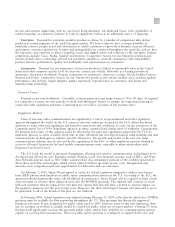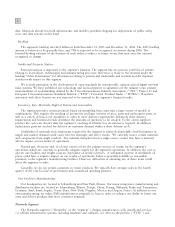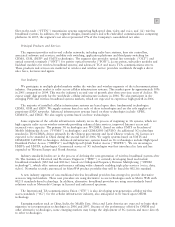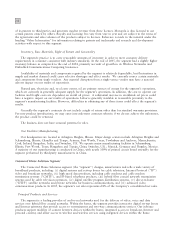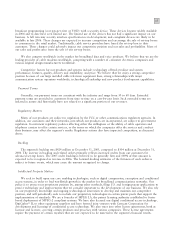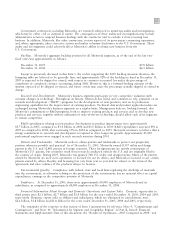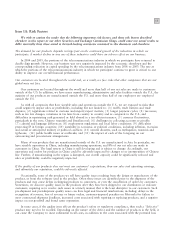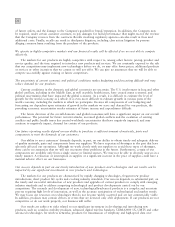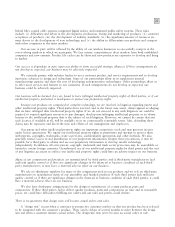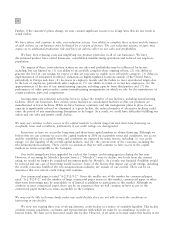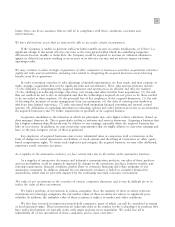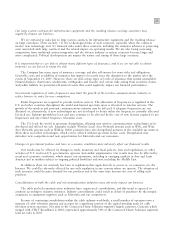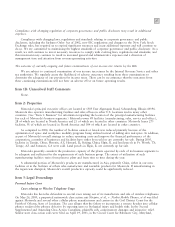Motorola 2005 Annual Report Download - page 24
Download and view the complete annual report
Please find page 24 of the 2005 Motorola annual report below. You can navigate through the pages in the report by either clicking on the pages listed below, or by using the keyword search tool below to find specific information within the annual report.
17
Government contractors, including Motorola, are routinely subjected to numerous audits and investigations,
which may be either civil or criminal in nature. The consequences of these audits and investigations may include
administrative action to suspend business dealings with the contractor and to exclude it from receiving new
business. In addition, Motorola, like other contractors, reviews aspects of its government contracting operations,
and, where appropriate, takes corrective actions and makes voluntary disclosures to the U.S. Government. These
audits and investigations could adversely affect Motorola's ability to obtain new business from the
U.S. Government.
Backlog. Motorola's aggregate backlog position for all Motorola segments, as of the end of the last two
fiscal years was approximately as follows:
December 31, 2005ÏÏÏÏÏÏÏÏÏÏÏÏÏÏÏÏÏÏÏÏÏÏÏÏÏÏÏÏÏÏÏÏÏÏÏÏÏÏÏÏÏÏÏÏÏÏÏÏÏÏÏÏÏÏÏÏÏÏÏÏÏÏÏÏ $7.8 billion
December 31, 2004ÏÏÏÏÏÏÏÏÏÏÏÏÏÏÏÏÏÏÏÏÏÏÏÏÏÏÏÏÏÏÏÏÏÏÏÏÏÏÏÏÏÏÏÏÏÏÏÏÏÏÏÏÏÏÏÏÏÏÏÏÏÏÏÏ $6.3 billion
Except as previously discussed in this Item 1, the orders supporting the 2005 backlog amounts shown in the
foregoing table are believed to be generally firm, and approximately 92% of the backlog on hand at December 31,
2005 is expected to be shipped or earned, with respect to contracts accounted for under the percentage of
completion or completed contract accounting, during 2006. However, this is a forward-looking estimate of the
amount expected to be shipped or earned, and future events may cause the percentage actually shipped or earned to
change.
Research and Development. Motorola's business segments participate in very competitive industries with
constant changes in technology. Throughout its history, Motorola has relied, and continues to rely, primarily on its
research and development (""R&D'') programs for the development of new products, and on its production
engineering capabilities for the improvement of existing products. Technical data and product application ideas are
exchanged among Motorola's business segments on a regular basis. Management believes, looking forward, that
Motorola's commitment to R&D programs, both to improve existing products and services and to develop new
products and services, together with its utilization of state-of-the-art technology, should allow each of its segments
to remain competitive.
R&D expenditures relating to new product development or product improvement were approximately
$3.7 billion in 2005, compared to $3.4 billion in 2004 and $3.0 billion in 2003. R&D expenditures increased 8% in
2005 as compared to 2004, after increasing 15% in 2004 as compared to 2003. Motorola continues to believe that a
strong commitment to research and development is required to drive long-term growth. Approximately 25,000
professional employees were engaged in such research activities during 2005.
Patents and Trademarks. Motorola seeks to obtain patents and trademarks to protect our proprietary
position whenever possible and practical. As of December 31, 2005, Motorola owned 8,557 utility and design
patents in the U.S. and 12,801 patents in foreign countries. These foreign patents are mostly counterparts of
Motorola's U.S. patents, but a number result from research conducted outside the U.S. and are originally filed in
the country of origin. During 2005, Motorola was granted 548 U.S. utility and design patents. Many of the patents
owned by Motorola are used in its operations or licensed for use by others, and Motorola is licensed to use certain
patents owned by others. Royalty and licensing fees vary from year to year and are subject to the terms of the
agreements and sales volumes of the products subject to licenses.
Environmental Quality. Compliance with federal, state and local laws regulating the discharge of materials
into the environment, or otherwise relating to the protection of the environment, has no material effect on capital
expenditures, earnings or the competitive position of Motorola.
Employees. At December 31, 2005, there were approximately 69,000 employees of Motorola and its
subsidiaries, as compared to approximately 68,000 employees at December 31, 2004.
Financial Information About Foreign and Domestic Operations and Export Sales. Domestic export sales to
third parties were $2.1 billion, $2.7 billion and $1.9 billion for the years ended December 31, 2005, 2004 and 2003,
respectively. Domestic export sales to affiliates and subsidiaries, which are eliminated in consolidation, were
$2.6 billion, $1.8 billion and $1.8 billion for the years ended December 31, 2005, 2004 and 2003, respectively.
The remainder of the response to this section of Item 1 incorporates by reference Note 9, ""Commitments and
Contingencies'' and Note 10, ""Information by Segment and Geographic Region'' of Part II, Item 8: Financial
Statements and Supplementary Data of this document, the ""Results of OperationsÌ2005 Compared to 2004'' and


